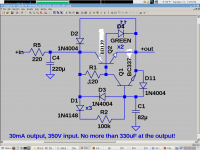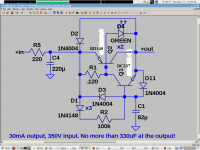Albert, what ripple frequency?
There is nothing simpler, cheaper, easier and more effective than using some high frequency inductors if you are dealing with frequencies above 100kHz for current less than 1A.
The K-Multiplier is brilliant in dealing with recified mains frequency (100Hz or 120Hz) with ripple reduction of 60dB and so and it provides a low output impedance. Practically no amount of capacitance can get you that much ripple reduction at such a frequency. But then if you are using the Salas reg, the reg is already much better in this area. While the K-Multiplier will work well up to 1MHz, the advantage of using the K-Multiplier is that (1) it doesn't burn as much power as a shunt reg; (2) it has a low voltage drop; (3) it has fairly good low frequency rejection of 60dB or so; and (4) it allows you to throw in any amount of low ESL capacitance at its output to deal with high frequency load.
So different horses for different courses. If you want to use the K Multiplier for some high frequency filtering, I would suggest that you may consider using passive LCR filters instead.
There is nothing simpler, cheaper, easier and more effective than using some high frequency inductors if you are dealing with frequencies above 100kHz for current less than 1A.
The K-Multiplier is brilliant in dealing with recified mains frequency (100Hz or 120Hz) with ripple reduction of 60dB and so and it provides a low output impedance. Practically no amount of capacitance can get you that much ripple reduction at such a frequency. But then if you are using the Salas reg, the reg is already much better in this area. While the K-Multiplier will work well up to 1MHz, the advantage of using the K-Multiplier is that (1) it doesn't burn as much power as a shunt reg; (2) it has a low voltage drop; (3) it has fairly good low frequency rejection of 60dB or so; and (4) it allows you to throw in any amount of low ESL capacitance at its output to deal with high frequency load.
So different horses for different courses. If you want to use the K Multiplier for some high frequency filtering, I would suggest that you may consider using passive LCR filters instead.
1N4148 is X3 right?
What's better for C1 82uF or 8,2uF?
Is this the proper orientation for BD139?
Attachments
I used two green LEDs 2V 20mA but don't lit, I checked & one was faulty I replaced for two new ones but still dont' lit, I checked the LEDs and both are OK.
In place of BC337 I used BC637, any suggestions where to start to fix the issue?
In place of BC337 I used BC637, any suggestions where to start to fix the issue?
Q2 needs to be a PNP! The BD140 is the PNP version, right? Emitter goes to input.
The BC637 is not a version of the BC3x7. If you don't have BC3x7, use BC5xx in the highest gain grade you can find.
The BC637 is not a version of the BC3x7. If you don't have BC3x7, use BC5xx in the highest gain grade you can find.
LEDs lit, sound 1st class combined with Salas SSHV2, thanks to share your work🙂
Hi Merlin
It seems you did it successfully.... please let us know your setup.
Are you using kean circuit before salas shunt ? What current are you using in salas ccs ?
And did you replace smoothing caps in the preregulator ?
Hi Merlin
It seems you did it successfully.... please let us know your setup.
Are you using kean circuit before salas shunt ? What current are you using in salas ccs ?
And did you replace smoothing caps in the preregulator ?
Is for my ECC81 mu-follower tube preamp, yes big improvement kean CFP cap multiplier vefore the SSHV2.
Wich pre-regulator: do you refer PSU?
In kean CFP cap multiplier I used Solen MKP 27uF 400V.
Thank you Merlin
I want to know what is the psu you are using before kean's circuit.
Transformer + rectifier bridge + Kean + capacitor + SSHV2 ?
I want to know what is the psu you are using before kean's circuit.
Transformer + rectifier bridge + Kean + capacitor + SSHV2 ?
Q2 needs to be a PNP! The BD140 is the PNP version, right? Emitter goes to input.
The BC637 is not a version of the BC3x7. If you don't have BC3x7, use BC5xx in the highest gain grade you can find.
and take the C extension
hFE DC current gain IC = -2 mA; VCE = -5 V;
BC556 min 125 - max 475
BC557 min 125 - max 800
BC556A min 125 - max 250
BC556B; BC557B min 220 - max 475
BC557C min 420 - max 800
Albert, what ripple frequency?
There is nothing simpler, cheaper, easier and more effective than using some high frequency inductors if you are dealing with frequencies above 100kHz for current less than 1A.
The K-Multiplier is brilliant in dealing with recified mains frequency (100Hz or 120Hz) with ripple reduction of 60dB and so and it provides a low output impedance. Practically no amount of capacitance can get you that much ripple reduction at such a frequency. But then if you are using the Salas reg, the reg is already much better in this area. While the K-Multiplier will work well up to 1MHz, the advantage of using the K-Multiplier is that (1) it doesn't burn as much power as a shunt reg; (2) it has a low voltage drop; (3) it has fairly good low frequency rejection of 60dB or so; and (4) it allows you to throw in any amount of low ESL capacitance at its output to deal with high frequency load.
So different horses for different courses. If you want to use the K Multiplier for some high frequency filtering, I would suggest that you may consider using passive LCR filters instead.
What I saw on the scope was a jump at the moment of conduction.
As Salas was so kind to tell me, my probes were wrong- having a non-shielded tip; after repairing I did not see the commutation anymore in the output.
In my Salas regulator, I found the CCS module (BC560+0,68 ohm resistor; IRF130) to be rather sensitive to the amount of regulation before the CCS. It could oscillate at the onset of the high inrush; even if the total RMS ripple was less than a volt, it triggered.
With the multiplier as pre-reg, the whole oscillation is gone, I can use wirewound resistor and there is no need to use expensive non-inductive resistors (I for instance have only 0,47 and 3,3 ohms fukushimas).
Thank you Merlin
I want to know what is the psu you are using before kean's circuit.
Transformer + rectifier bridge + Kean + capacitor + SSHV2 ?
Tx + valve rectifier + 220uF + 75R + 220uF + kean + SSHV2
Thank you Merlin, so you did not replace the smoothing caps for the kean... just added the multiplier before the shunt right ?
I will try the kean replacing the smoothing caps in my next paradise build.... It will take a while but I will do it by the book 🙂
I found the CCS module (BC560+0,68 ohm resistor; IRF130) to be rather sensitive to the amount of regulation before the CCS. It could oscillate at the onset of the high inrush; even if the total RMS ripple was less than a volt, it triggered.
With the multiplier as pre-reg, the whole oscillation is gone, I can use wirewound resistor and there is no need to use expensive non-inductive resistors (I for instance have only 0,47 and 3,3 ohms fukushimas).
Is that a 1.2R? IRF130 has 650pF Ciss VS 170pF of the designated IRF9610.
Is that a 1.2R? IRF130 has 650pF Ciss VS 170pF of the designated IRF9610.
You are so helpful!
Anyway, with the multiplier in front I see no oscilations anymore (and what you don't is what you haven't got.
[The inverse, - What you see is what you've got - is not true as you pointed out earlier to me, when I was measuring artifacts 🙂
I have 0,68 for about 850 mA.
- Home
- Amplifiers
- Power Supplies
- Keantoken's CFP cap multiplier

